#brandon hurst
Photo

The Man Who Laughs
directed by Paul Leni, 1928
38 notes
·
View notes
Text

John Barrymore and Brandon Hurst in Dr. Jekyll and Mr. Hyde (1920)
92 notes
·
View notes
Text


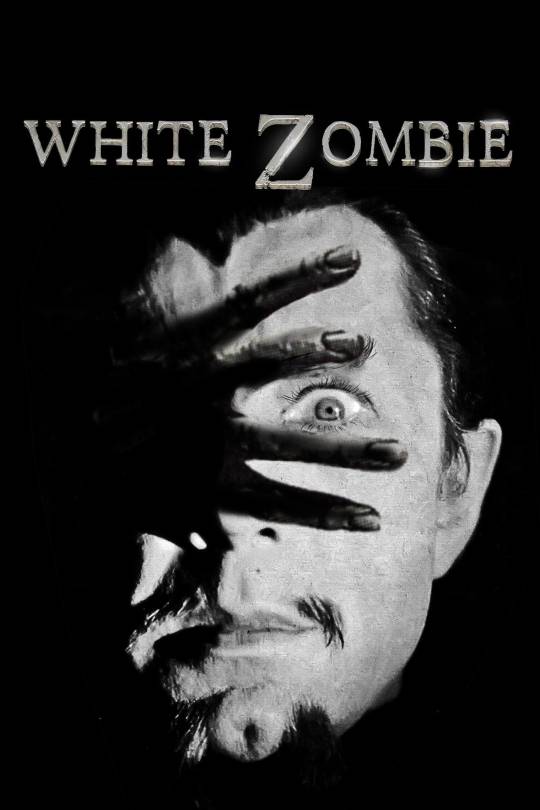



W A T C H E D
#WHITE ZOMBIE (1932)#BELA LUGOSI#madge bellamy#John Harron#Robert Frazer#Joseph Cawthorn#Frederick Peters#Brandon Hurst#Clarence Muse#independent horror#gothic horror#Supernatural horror#watching
3 notes
·
View notes
Text

"-What an interesting fellow." I said, watching the Man Who Laughs (1928) for the first time and letti g my goblin brain do the rest.
#sketches#spider-man#the man who laughs#barkipheldro#green goblin#brandon hurst#marvel#my art#Jester
5 notes
·
View notes
Photo

#the hunchback of notre dame#lon chaney#patsy ruth miller#norman kerry#brandon hurst#raymond hatton#ernest torrance#nigel de brulier#wallace worsley#1923
17 notes
·
View notes
Photo

Films Watched in 2023:
38. He Who Gets Slapped (1924) - Dir. Victor Sjöström
#He Who Gets Slapped#Victor Sjöström#Lon Chaney#Norma Shearer#John Gilbert#Ruth King#Marc McDermott#Ford Sterling#Tully Marshall#Brandon Hurst#Silent Cinema#Films Watched in 2023#My Post
2 notes
·
View notes
Photo

Bad movie I have Dr. Jekyll and Mr. Hyde 1920
#Dr. Jekyll and Mr. Hyde#Paramount#John Barrymore#Brandon Hurst#Martha Mansfield#Charles Lane#Cecil Clovelly#Nita Naldi#Louis Wolheim#Alma Aiken#J. Malcolm Dunn#Ferdinand Gottschalk#Julia Hurley#Jack McHugh#Georgie Drew Mendum#Blanche Ring#May Robson#George Stevens#Edgard Varèse
2 notes
·
View notes
Text
White Zombie | Episode 387
New Post has been published on https://esonetwork.com/white-zombie/
White Zombie | Episode 387

Jim looks at a 1932 Bela Lugosi Horror Classic from Halperin Productions – “White Zombie,” Starring Lugosi, Madge Bellamy, Joseph Cawthorne, Robert W. Frazier, John Harron, Brandon Hurst, George Burr Macannan and Clarence Muse. A Haitian plantation owner sets hi sights on a young woman and has her turned into zombie to have her to himself. Find out more about this first zombie film on MONSTER ATTACK!, The Podcast Dedicated To Old Monster Movies.
#1932 Zombie Film#Bela Lugos#Brandon Hurst#Clarence Muse#ESO Network#First Zombie Film#geek podcast#George Burr Macannan#Halperin Production#Jim Adams#John Harron#Joseph Cawthorne#Madge Bellamy#Monster Attack!#nerd podcast#Robert W. Frazier#The ESO Network#White Zombie
0 notes
Photo









faceclaims suggestions (14/?)
BOLD & BUZZED, MEN EDITION. (from top left to bottom right) #discover
lee tae kyun, corey baptiste, brandon browne, paulo spencer, curraun, isaac irvine, ben hurst, jean chang, vincent marc.
_______________________________________________________________________
❀ made by/credits: kawaiinekoj (instagram)
❀ like/reblog if you use or appreciate this
#kawaiinekoj#discover#icons#random icons#200x200#lee tae kyun#corey baptiste#brandon browne#paulo spencer#curraun#isaac irvine#ben hurst#jean chang#vincent marc#underused faceclaims#underused fc#fc search#fc hunt#fc help#buzzcut#faceclaim suggestion
24 notes
·
View notes
Text
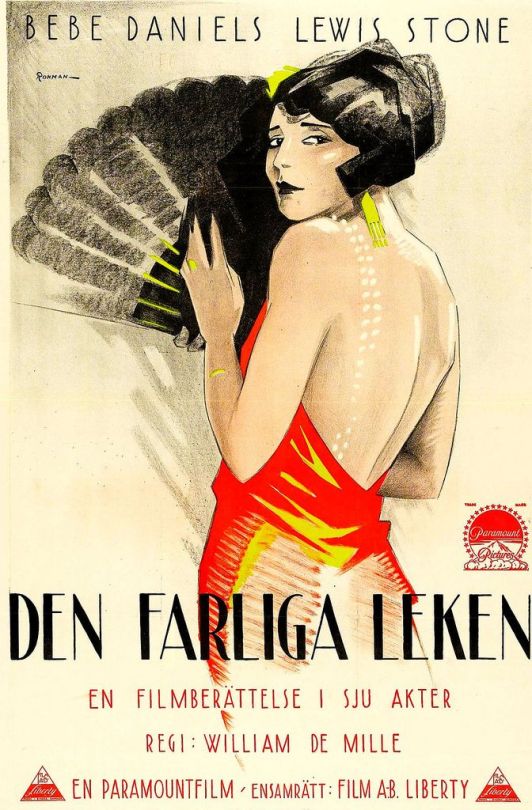


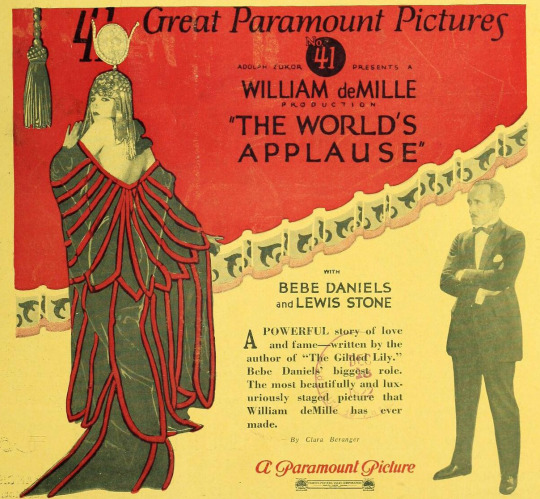
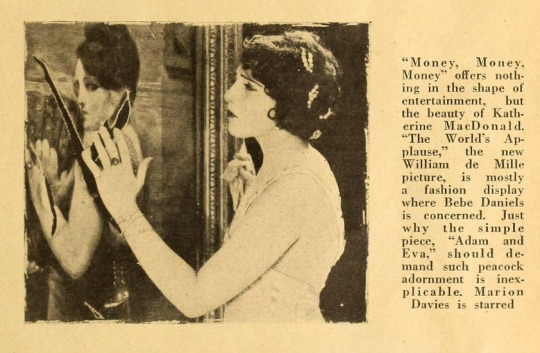


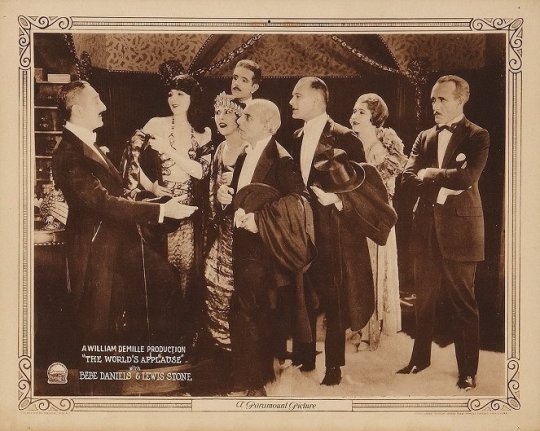
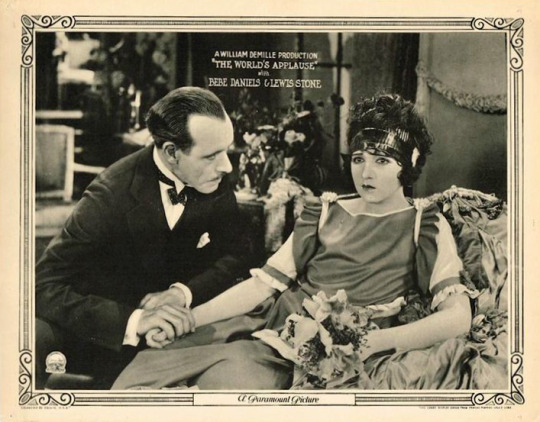
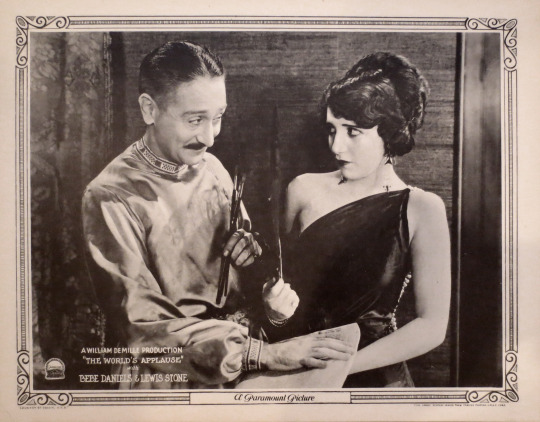
Lost, but Not Forgotten: The World’s Applause (1923)
Direction: William C. de Mille
Scenario & Titles: Clara Beranger (more about Beranger at the Women Film Pioneers Project)
Camera: L. Guy Wilky
Sets & Costumes: Paul Iribe
Studio: Famous Players-Lasky (production) & Paramount (distribution)
Performers: Bebe Daniels, Lewis Stone, Kathlyn Williams, Adolphe Menjou, Brandon Hurst, Bernice Frank, Maym Kelso, George Kuwa, James Neill
Status: presumed entirely lost
Synopsis (synthesized from magazine summaries of the plot):
Corinne D’Alys (Bebe Daniels), f.k.a. Cora Daly, is a theater star who has “taken the Rialto by storm.” Unfortunately, Corinne also has a desperate hunger for publicity. Her manager, John Elliott (Lewis Stone), who also happens to be in love with her, advises her to be more sensible about her career. A famous artist, Robert Townsend (Adolphe Menjou), has become enamored with Corinne, and wants to paint her portrait. Despite John’s warning that Robert wishes only to “see more of her,” Corinne sits for the portrait.
Robert plans on throwing a party to celebrate finishing the painting but declines to invite his wife, Elsa Townsend (Kathlyn Williams). Elsa comes to her husband’s studio anyway and finds the portrait and a pearl headdress that Robert is going to gift to Corinne. In a jealous rage, Elsa takes a knife to the painting and then to her husband—fatally stabbing him. Elsa also happens to be John’s sister and she calls him in a panic to help her. John arrives at the studio in secret and helps Elsa escape the scene. Meanwhile, Corinne and the guests begin to wonder where their host is, and Corinne then finds the body of the painter.
John convinces the police that Corinne is innocent. Corinne leaves town to avoid the storm. Unfortunately, John then becomes the primary suspect, as he had a notable fight with his brother-in-law months prior. When John is arrested, Corinne returns and confesses to Elsa that she feels morally responsible for Robert’s murder. Elsa then confesses to committing the murder herself. It’s implied that Elsa commits suicide via “the watery route.”
Now that both John and Corinne have been cleared of suspicion, they are free to marry and Corinne has lost her appetite for publicity.
Transcribed sources & annotations below:
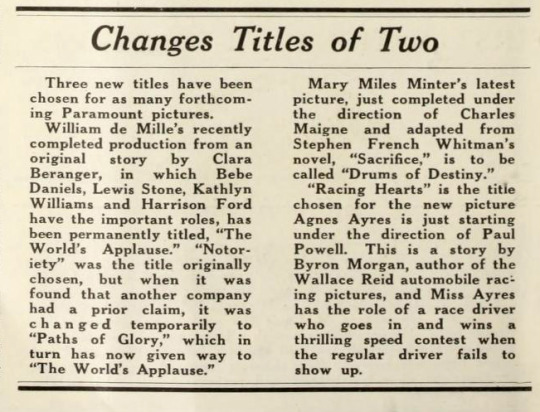
Moving Picture World, November 11, 1922
News from the Producers
Conducted by T.S. da Ponte
Changes Titles of Two
Three new titles have been chosen for as many forthcoming Paramount pictures.
William de Mille’s recently completed production from an original story by Clara Beranger, in which Bebe Daniels, Lewis Stone, Kathlyn Williams and Harrison Ford have the important roles, has been permanently titled, “The World’s Applause.” “Notoriety” was the title originally chosen, but when it was found that another company had a prior claim, it was changed temporarily to “Paths of Glory,” which in turn has now given way to “The World’s Applause.”
Mary Miles Minter's latest picture, just completed under the direction of Charles Maigne and adapted from Stephen French Whitman's novel, "Sacrifice," is to be called "Drums of Destiny."
"Racing Hearts" is the title chosen for the new picture Agnes Ayres is just starting under the direction of Paul Powell. This is a story by Byron Morgan, author of the Wallace Reid automobile racing pictures, and Miss Ayres has the role of a race driver who goes in and wins a thrilling speed contest when the regular driver fails to show up.
Both "Drums of Destiny" (titled "Drums of Fate" on release in 1923) and "Racing Hearts" are also lost films.


Exhibitor’s Herald, January 20, 1923
REVIEWS
BEBE DANIELS IN
WORLD’S APPLAUSE
(PARAMOUNT)
A fascinating story of the life of an actress who unwittingly becomes involved in a murder mystery which almost brings about her downfall professionally. Lavishly presented, very well acted and directed in William deMille’s best style. Length, 6,528 feet.
An original story by Clara Beranger provides Bebe Daniels, Lewis Stone, Kathlyn Williams, Adolph Menjou and others with a suitable vehicle in which to display their talents. There is good story interest for the most part, with good surprise value and considerable dramatic suspense in the contest of wits between the detectives and John Elliott and his sister.
Lewis Stone plays the role of Elliot and gives an unusually convincing and consistent characterization. The director, author and producer are to be congratulated upon securing Mr. Stone’s services for this part. Miss Daniels appears in the role of an actress who is a hound for publicity, and the moral of the story shows how ready the public is to condemn these children of the stage. Kathlyn Williams has the role of Elsa Townsend, wife of an artist in love with the little actress, who in a fit of jealousy kills her husband. A difficult role, but played with restraint and conviction. Adolphe Menjou is the artist. Bernice Frank was the maid; Mayme Kelso, secretary to the actress, and George Kuwa, valet to Townsend. James Neill was Elliot’s valet, while Brandon Hurst played James Crane, owner of a string of newspapers.
Corinne d’Alys, popular Broadway star, poses for Townsend while he paints her portrait. On the day he is to display the painting he gives a party at his studio. As the guests assemble, Mrs. Townsend comes to the studio, discovers a valuable pearl headdress which her husband is to give to Corinne, and the portrait of the actress. In a fit of jealousy she strikes him down and leaves the studio with her brother, John Elliot. The discovery of the dead artist throws suspicion upon the members of the party. Corinne telephones to her affianced husband Elliott and he succeeds in convincing the police that she is innocent. Crane takes a hand in the investigation, however, and dogs Elliott’s footsteps. A confession from Mrs. Townsend finally clears Elliott and the little actress, and she no longer seeks the world’s applause, but is content to settle down with John.
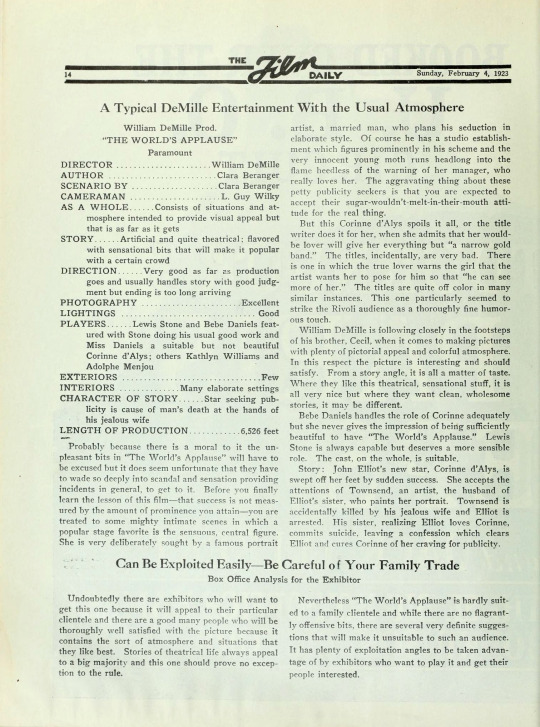
The Film Daily, February 2, 1923
A Typical DeMille Entertainment With the Usual Atmosphere
William DeMille Prod.
“THE WORLD’S APPLAUSE”
Paramount
DIRECTOR…William DeMille
AUTHOR…Clara Beranger
SCENARIO BY…Clara Beranger
CAMERAMAN…L. Guy Wilky
AS A WHOLE…Consists of situations and atmosphere intended to provide visual appeal but that is as far as it gets
STORY…Artificial and quite theatrical; flavored with sensational bits that will make it popular with a certain crowd
DIRECTION… Very good as far as production goes and usually handles story with good judgment but ending is too long arriving
PHOTOGRAPHY…Excellent
LIGHTINGS… Good
PLAYERS… Lewis Stone and Bebe Daniels featured with Stone doing his usual good work and Miss Daniels a suitable but not beautiful Corinne d’Alys; others Kathlyn Williams and Adolphe Menjou
EXTERIORS…Few
INTERIORS… Many elaborate settings
CHARACTER OF STORY…Star seeking publicity is cause of man’s death at the hands of his jealous wife
LENGTH OF PRODUCTION… 6,526 feet
Probably because there is a moral to it the unpleasant bits in “The World’s Applause” will have to be excused but it does seem unfortunate that they have to wade so deeply into scandal and sensation providing incidents in general, to get to it. Before you finally learn the lesson of this film—that success is not measured by the amount of prominence you attain—you are treated to some mighty intimate scenes in which a popular stage favorite is the sensuous, central figure. She is very deliberately sought by a famous portrait artist, a married man, who plans his seduction in elaborate style. Of course he has a studio establishment which figures prominently in his scheme and the very innocent young moth runs headlong into the flame heedless of the warning of her manager, who really loves her. The aggravating thing about these petty publicity seekers is that you are expected to accept their sugar-wouldn’t-melt-in-their-mouth attitude for the real thing.
But this Corinne d’Alys spoils it all, or the title writer does it for her, when she admits that her would-be lover will give her everything but “a narrow gold band.” The titles, incidentally, are very bad. There is one in which the true lover warns the girl that the artist wants her to pose for him so that “he can see more of her.” The titles are quite off color in many similar instances. This one particularly seemed to strike the Rivoli audience as a thoroughly fine humorous touch.
William DeMille is following closely in the footsteps of his brother, Cecil, when it comes to making pictures with plenty of pictorial appeal and colorful atmosphere. In this respect the picture is interesting and should satisfy. From a story angle, it is all a matter of taste. Where they like theatrical, sensational stuff, it is all very nice but where they want clean, wholesome stories, it may be different.
Bebe Daniels handles the role of Corinne adequately but she never gives the impression of being sufficiently beautiful to have “The World’s Applause.” Lewis Stone is always capable but deserves a more sensible role. The cast, on the whole, is suitable.
Story: John Elliot’s new star, Corinne d’Alys, is swept off her feet by sudden success. She accepts the attentions of Townsend, an artist, the husband of Elliot’s sister, who paints her portrait. Townsend is accidentally killed by his jealous wife and Elliot is arrested. His sister, realizing Elliot loves Corinne, commits suicide, leaving a confession which clears Elliot and cures Corinne of her craving for publicity.
One of those negative reviews that makes you want to watch a movie more, eh? Moralizing and misogyny on full display! Phew.
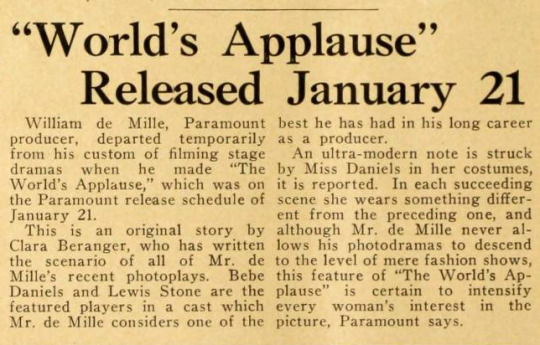
The Moving Picture World, February 1923
“World’s Applause” Released January 21
William de Mille, Paramount producer, departed temporarily from his custom of filming stage dramas when he made "The World's Applause," which was on the Paramount release schedule of January 21.
This is an original story by Clara Beranger, who has written the scenario of all of Mr. de
Mille's recent photoplays. Bebe Daniels and Lewis Stone are the featured players in a cast which Mr. de Mille considers one of the best he has had in his long career as a producer.
An ultra-modern note is struck by Miss Daniels in her costumes, it is reported. In each succeeding scene she wears something different from the preceding one, and although Mr. de Mille never allows his photodramas to descend to the level of mere fashion shows, this feature of "The World's Applause" is certain to intensify every woman's interest in the picture, Paramount says.

Variety, February 1923
WORLD'S APPLAUSE
Paramount picture presented by Adolph Zukor. William DeMille production, featuring Bebe Daniels, Lewis Stone and Kathlyn Williams in story by Clara Beranger.
At the Rivoli, New York, week of Jan. 28.
Corinne d'Alys..........Bebe Daniels
John Elliot........Lewis Stone
Elsa Townsend...Kathlyn Willams
Robert Townsend, her husband…Adolphe Menjou
James Crane...Brandon Hurst
Maid to Corinne...Bernice Frank
Secretary to Corinne.........Maym Kelso
Valet to Townsend..George Kuwa
Valet to Elliot......James Neill
“The World's Applause" is a screen treatise on theatrical publicity and exploitation with a twist that a certain theatrical personage's craving for newspaper "notices" and the desire to be the talk of the town boomerangs viciously when she is indirectly implicated in a murder mystery.
The theatrical personage is Corinne d'Alys (born Cora Daly), who has "taken the Rialto by storm," but who is counselled by her manager-lover (Lewis Stone) to cease her craving for the world's applause and deal seriously with her work. This is momentarily disparaged by her
with ensuing developments taking the audience rather interestingly through the usual five-reel span.
It starts with Robert Townsend, an artist who has "arrived" (Adolphe Menjou), becoming enamored with the favored and favorite footlights beauty and honoring her with painting her portrait for the annual Parisian exhibition. Townsend is married to the sister of John Elliot, the impresario, and a parallel situation develops of Townsend slighting his wife for Corinne, and
Townsend interposing himself between the actress and her suitor, Elliot.
At a studio party in Corinne's honor to which Townsend did not invite his wife, the latter enters
through the private studio door and, enraged at her husband's nonchalance, slashes the portrait and stabs the artist fatally. She telephones for her brother, who also enters unbeknown to the guests in the outer rooms. Both slip away, but not without being seen by a newspaper
publisher, whose testimony implicates Elliot, who shields his sister. Elliot is arrested on first degree murder charges, but is absolved when his sister confesses to Corinne. The sister runs away, and there is a suggestion she commits suicide via the watery route.
Not much to the story, but rather deftly handled by DeMille in his customary pretentious manner—never lavish but always in good taste. The captioning is pithy and bright, and such leaders as "the public always believes the worst about an actress" is good lay propaganda for the profession.
Miss Daniels sports a nobby collection of clothes to excellent advantage. Mr. Stone is a sincere opposite, who also has the ability of really acting when called upon. Miss Williams, too, accounted for herself handily.
The picture pleased at the Rivoli
Abel
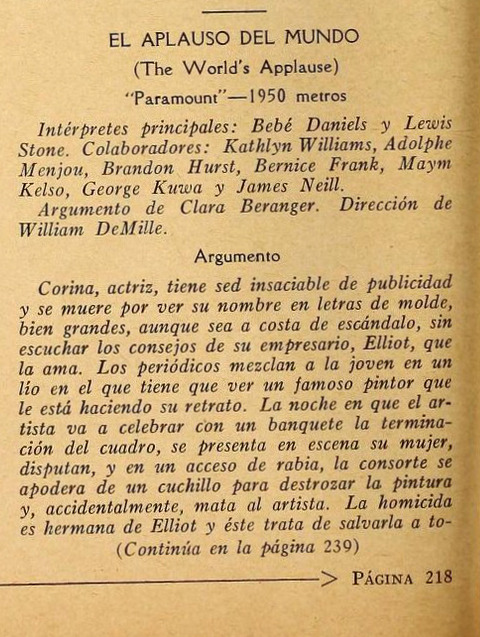
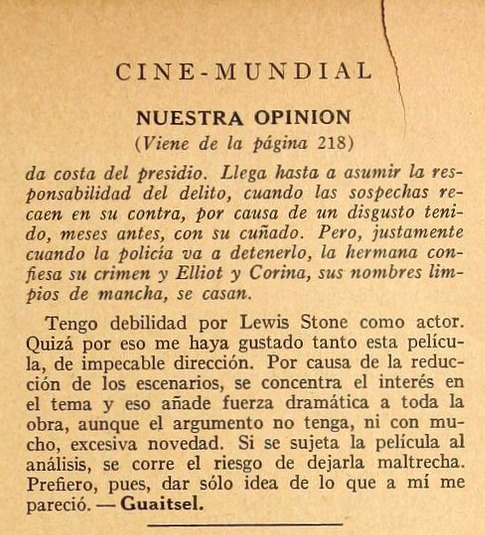
Cine-Mundial, April 1923 p. 218 & 239
EL APLAUSO DEL MUNDO
(The World’s Applause)
“Paramount” — 150 metros
Intérpretes principales: Bebé Daniels y Lewis Stone. Colaboradores: Kathryn Williams, Adolphe Menjou, Brandon Hurst, Bernice Frank, Maym Kelso, George Kuwa y James Neill.
Argumento de Clara Beranger. Dirección de William DeMille.
Argumento
Corina, actriz, tiene sed insaciable de publicidad y se muere por ver su nombre en letras de molde, bien grandes, aunque sea a costa de escándalo, sin escuchar los consejos de su empresario, Elliot, que la ama. Los periódicos mezclan a la joven en un lío en el que ver un famoso pintor que le está haciendo su retrato. La noche en que el artista va a celebrar con un banquete la terminación del cuadro, se presenta en escena su mujer, disputan, y en un acceso de rabia, la consorte se apodera de un cuchillo para destrozar la pintura y, accidentalmente, mata al artista. La homicida es hermana de Elliot y éste trata de salvarla a to-
(Continúa en la página 239)
NUESTRA OPINION
(Viene de la página 218)
da costa del presidio. Llega hasta a asumir la responsabilidad del delito, cuando las sospechas recaen en su contra, por causa de un disgusto tenido, meses antes, con su cuñado. Pero, justamente cuando la policía va a detenerlo, la hermana confiesa su crimen y Elliot y Corina, sus nombres limpios de mancha, se casan.
Tengo debilidad por Lewis Stone como actor. Quizá por eso me haya gustado tanto esta película, de impecable dirección. Por causa de la reducción de los escenarios, se concentra el interés en el tema y eso añade fuerza dramática a toda la obra, aunque el argumento no tenga, ni con mucho, excesiva novedad. Si se sujeta la película al análisis, se corre el riesgo de dejarla maltrecha. Prefiero, pues, dar sólo idea de lo que a mi me pareció. — Guaitsel.
Translation:
Lead actors: Bebe Daniels and Lewis Stone. Supporting actors: Kathlyn Williams, Adolphe Menjou, Brandon Hurst, Bernice Frank, Maym Kelso, George Kuwa and James Neill.
Scenario by Clara Beranger. Direction by WIlliam DeMille.
Scenario
Corina, an actress, has an insatiable thirst for publicity and would die to see her name in lights, even at the cost of scandal, without listening to the advice of her manager, Elliot, who loves her. The newspapers mix the young woman up in an imbroglio with a famous painter, who is painting her portrait. On the night that the artist is going to celebrate the completion of the painting with a banquet, his wife appears on the scene, they argue, and in a fit of rage, the wife seizes a knife to destroy the painting and, accidentally, kills the artist. The murderer is Elliot’s sister and he tries to save her from prison at all costs. He goes as far as assuming responsibility for the crime, when suspicion falls on him, due to a disagreement he had with his brother-in-law, months before. But, just as the police are going to arrest him, the sister confesses her crime and Elliot and Corina, their names clean, get married.
I have a soft spot for Lewis Stone as an actor. Maybe that’s why I liked this impeccably-directed film so much. Because of the limitation of settings, interest is concentrated on the theme and this adds dramatic force to the whole work, even though the scenario isn’t very excessively novel at all. If you subject the film to analysis, you run the risk of dealing damage to it. I prefer then to give only the outline of how it seemed to me. — Guaitsel.
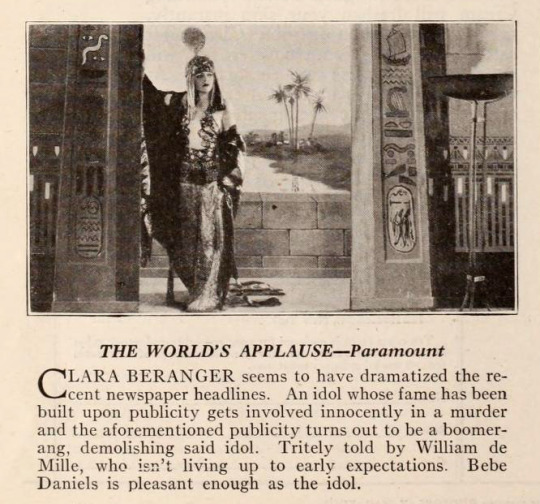
Photoplay, April 1923
THE WORLD’S APPLAUSE—Paramount
CLARA BERANGER seems to have dramatized the recent newspaper headlines. An idol whose fame has been built upon publicity gets involved innocently in a murder and the aforementioned publicity turns out to be a boomerang, demolishing said idol. Tritely told by William de Mille, who isn’t living up to early expectations. Bebe Daniels is pleasant enough as the idol.
Presumably, this writer is alluding to the Mary Miles Minter / William Desmond Taylor scandal from February of 1922. Kind of an interesting assumption given that, at the time, Minter was still under contract with Famous Player-Lasky, the same company that produced The World’s Applause.
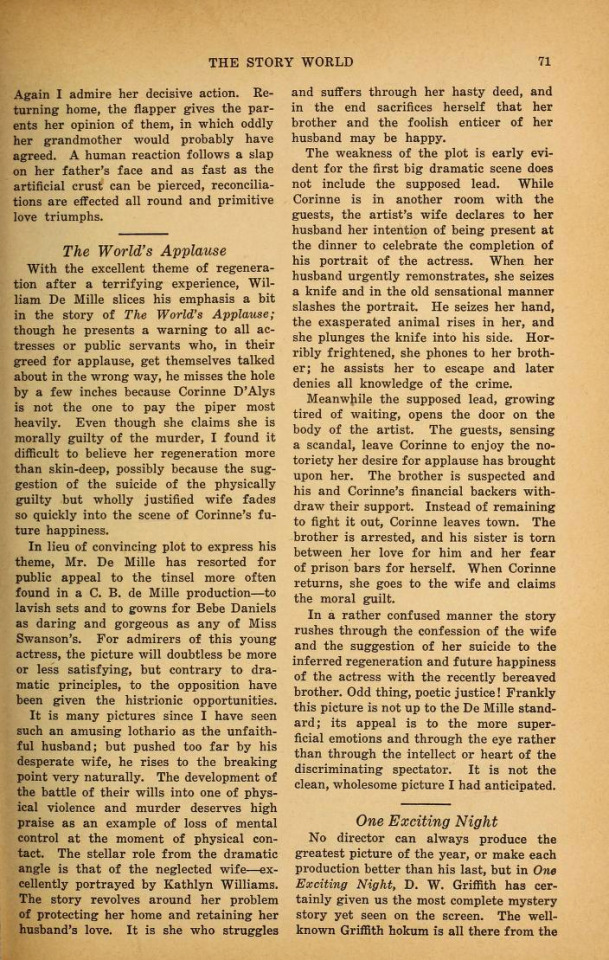
The Story World and Photodramatist, April 1923
The World's Applause
With the excellent theme of regeneration after a terrifying experience, William De Mille slices his emphasis a bit in the story of The World's Applause; though he presents a warning to all actresses or public servants who, in their greed for applause, get themselves talked about in the wrong way, he misses the hole by a few inches because Corinne D'Alys is not the one to pay the piper most heavily. Even though she claims she is morally guilty of the murder, I found it
difficult to believe her regeneration more than skin-deep, possibly because the suggestion of the suicide of the physically guilty but wholly justified wife fades so quickly into the scene of Corinne's future happiness.
In lieu of convincing plot to express his theme, Mr. De Mille has resorted for public appeal to the tinsel more often found in a C. B. de Mille production—to lavish sets and to gowns for Bebe Daniels as daring and gorgeous as any of Miss Swanson's. For admirers of this young actress, the picture will doubtless be more or less satisfying, but contrary to dramatic principles, to the opposition have been given the histrionic opportunities
It is many pictures since I have seen such an amusing lothario as the unfaithful husband; but pushed too far by his desperate wife, he rises to the breaking point very naturally. The development of the battle of their wills into one of physical violence and murder deserves high
praise as an example of loss of mental control at the moment of physical contact. The stellar role from the dramatic angle is that of the neglected wife—excellently portrayed by Kathlyn Williams. The story revolves around her problem of protecting her home and retaining her
husband's love. It is she who struggles and suffers through her hasty deed, and in the end sacrifices herself that her brother and the foolish enticer of her husband may be happy.
The weakness of the plot is early evident for the first big dramatic scene does not include the supposed lead. While Corinne is in another room with the guests, the artist's wife declares to her husband her intention of being present at the dinner to celebrate the completion of his portrait of the actress. When her husband urgently remonstrates, she seizes a knife and in the old sensational manner slashes the portrait. He seizes her hand, the exasperated animal rises in her, and she plunges the knife into his side. Horribly frightened, she phones to her brother; he assists her to escape and later denies all knowledge of the crime.
Meanwhile the supposed lead, growing tired of waiting, opens the door on the body of the artist. The guests, sensing a scandal, leave Corinne to enjoy the notoriety her desire for applause has brought upon her. The brother is suspected and his and Corinne's financial backers withdraw their support. Instead of remaining to fight it out, Corinne leaves town. The brother is arrested, and his sister is torn between her love for him and her fear of prison bars for herself. When Corinne returns, she goes to the wife and claims the moral guilt.
In a rather confused manner the story rushes through the confession of the wife and the suggestion of her suicide to the inferred regeneration and future happiness of the actress with the recently bereaved brother. Odd thing, poetic justice! Frankly this picture is not up to the De Mille standard; its appeal is to the more superficial emotions and through the eye rather than through the intellect or heart of the discriminating spectator. It is not the clean, wholesome picture I had anticipated.
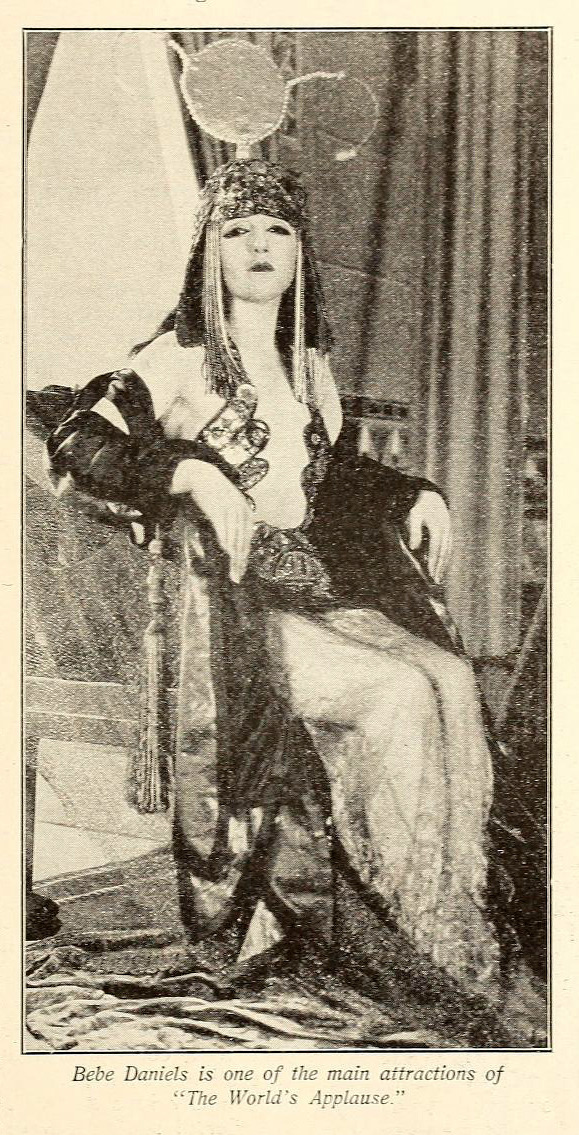
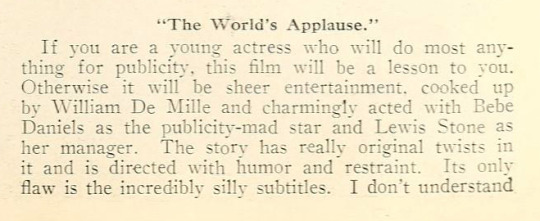

Picture Play Magazine, May 1923
The Screen in Review
“The World’s Applause.”
If you are a young actress who will do most anything for publicity, this film will be a lesson to you. Otherwise it will be sheer entertainment, cooked up by William De Mille and charmingly acted with Bebe Daniels as the publicity-mad star and Lewis Stone as her manager. The story has really original twists in it and is directed with humor and restraint. Its only flaw is the incredibly silly subtitles. I don’t understand how Mr. De Mille let them get by in one of his productions which always bear a certain imprint of good taste and sophistication.
#1920s#1923#The World's Applause#Bebe Daniels#William C. de Mille#lewis stone#silent era#silent movies#silent film#lost film#vamps#kathlyn williams#Clara Beranger#film magazine#movie magazine#Women Film Pioneers#classic movies#classic film#film history#Mary Miles Minter#lost but not forgotten
30 notes
·
View notes
Text
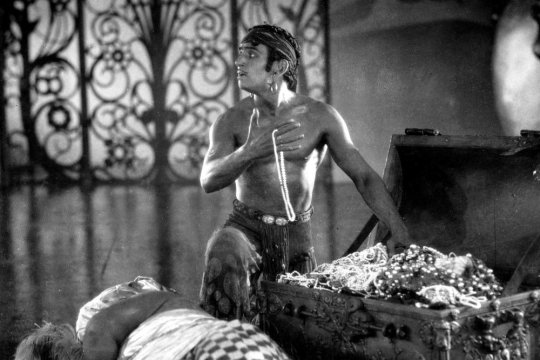
Douglas Fairbanks in The Thief of Bagdad (Raoul Walsh, 1924)
Cast: Douglas Fairbanks, Julianne Johnston, Anna May Wong, Snitz Edwards, Sojin Kamayama, Brandon Hurst, Tote Du Crow, Noble Johnson. Screenplay: Lotta Woods, Douglas Fairbanks, Achmed Abdullah, James T. O'Donohoe. Cinematography: Arthur Edeson. Production design: William Cameron Menzies. Film editing: William Nolan.
Back when Bagdad was synonymous with flying carpets and not prolonged international conflict, Douglas Fairbanks produced what is either a magical romp or an example of Orientalism at its worst, depending on your point of view. But for the purposes of film history, let's suspend political and social consciousness and appreciate The Thief of Bagdad for what it accomplished: an amusing spectacle, with marvelous sets and (for the time) remarkable special effects. Add to that Fairbanks's energetic performance -- if you can endure the balletic pantomime he often slips into -- and you've got a classic for the usual kids of all ages. It holds up well even today, in part because it's all spectacle: Sound would be superfluous. And yes, Sojin Kamayama's Mongol prince adheres to the "yellow peril" stereotype, a foreshadowing of Flash Gordon's Ming the Merciless, with Anna May Wong slinking around as his partner in malfeasance, but we're treating this as camp, right? Julianne Johnston's princess is a little vapid, not quite the astonishing beauty who's supposed to sweep the thief off his feet and turn him away from larceny toward love. The movie is a shade too long, and it loses some momentum when the thief goes off on his quest to find the thing that will win the princess's love. Even though it helps him save Bagdad from the Mongol hordes, I found his box of magic powder (if that's what it is -- the movie is a little vague about it) less impressive than the Persian prince's (Mathilde Comont) flying carpet, the Indian Prince's (Noble Johnson) crystal ball, and the Mongol prince's golden apple that gives him power over life and death. But even when the story lags, there's always something fun to watch.
3 notes
·
View notes
Text
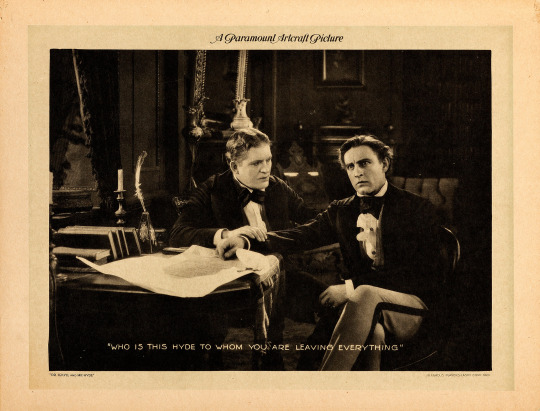
Dr. Jekyll and Mr. Hyde (1920)
38 notes
·
View notes
Photo

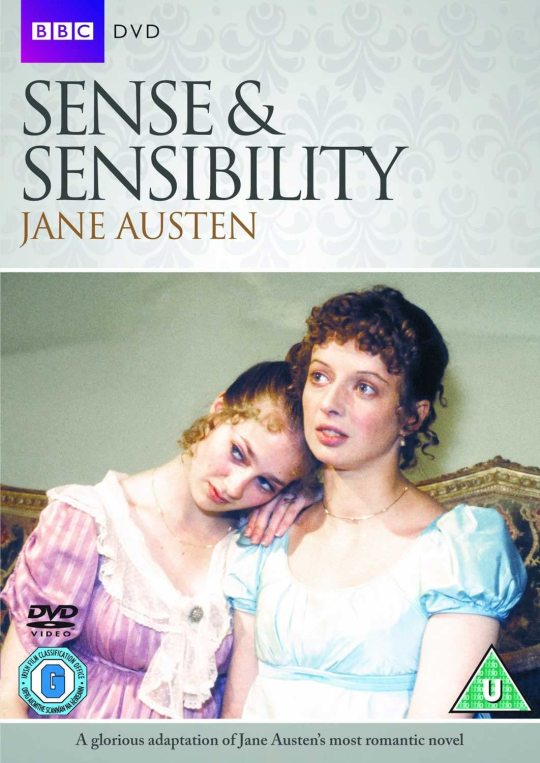





Sense and Sensibility
Classic and loose adaptions from 1971, 1981, 1995, 2000, 2008, 2011(x2)
The first of Jane Austen’s novels, first published in 1811, has had many adaptions over the years. The ones pictures above are detailed below:
Sense and Sensibility (1971 Miniseries)
4 episodes x 45 min
Written by Denis Constanduros, directed by David Giles
Starring Joanna David as Elinor Dashwood, Ciaran Madden as Marianne Dashwood, Robin Ellis as Edward Ferrars, Richard Owens as Colonel Brandon, Clive Francis as John Willoughby, among others.
Sense and Sensibility (1981 Miniseries)
7 episodes x 25 min
Written by Alexander Baron, directed by Rodney Bennett
Starring Irene Richard as Elinor Dashwood, Tracey Childs as Marianne Dashwood, Bosco Hogan as Edward Ferrars, Robert Swann as Colonel Brandon, Peter Woodward as John Willoughby, among others.
Sense and Sensibility (1995 Film)
Written by Emma Thompson, directed by Ang Lee
Starring Emma Thompson as Elinor Dashwood, Kate Winslet as Marianne Dashwood, Hugh Grant as Edward Ferrars, Alan Rickman as Colonel Brandon, Greg Wise as John Willoughby, among others.
Kandukondain Kandukondain (I Have Found It) (2000 Film)
Indian Tamil-language musical film. Loose adaption set in modern India
Written by Rajiv Menon and Sujatha, directed by Rajiv Menon
Starring Tabu as Sowmya (Elinor), Aishwarya Rai as Meenakshi (Marianne), Ajith Kumar as Manohar (Edward), Mammootty as Major Bala (Brandon), Abbas as Srikanth (Willoughby), among others.
Only Meenakshi, Manohar and Srikanth have singing parts (Sowmya appears in a few musical numbers).
Sense and Sensibility (2018 Miniseries)
3 episodes x 50 min
Written by Andrew Davies, directed by John Alexander
Starring Hattie Morahan as Elinor Dashwood, Charity Wakefield as Marianne Dashwood, Dan Stevens as Edward Ferrars, David Morrissey as Colonel Brandon, Dominic Cooper as John Willoughby, among others.
From Prada to Nada (2011 Film)
Loose adaption set in modern Los Angeles, USA
Written by Fina Torres, Luis Alfaro, Craig Fernandez; directed by Angel Gracia
Starring Camilla Belle as Nora Dominguez (Elinor), Alexa Vega as Mary Dominguez (Marianne), Nicholas D'Agosto as Edward Ferris, Wilmer Valderrama as Bruno (Brandon), Kuno Becker as Rodrigo Fuentes (Willoughby), among others.
Scents and Sensibility (2011 TV Film)
Loose adaption set in modern US
Written by Jennifer Jan, Brittany Wiscombe; directed by Brian Brough
Starring Ashley Williams as Elinor Dashwood, Marla Sokoloff as Marianne Dashwood, Brad Johnson as Edward Farrirs, Nick Zano as Brandon Hurst, Jason Celaya as John Willoughby, among others.
*****
Personal favorites: 2008, then 1995.
#sense and sensibility#period drama#elinor dashwood#marianne dashwood#sense and sensibility 95#sense and sensibility 2008#jane austen adaptations#edward ferrars#colonel brandon#I have found it#from prada to nada#kandukondain kandukondain#scents and sensibility#sense and sensibility 1981#sense and sensibility 1971
20 notes
·
View notes
Text

#Murders in the Rue Morgue#Bela Lugosi#Sidney Fox#Leon Ames#Bert Roach#Brandon Hurst#Noble Johnson#D'Arcy Corrigan#Robert Florey#1932
1 note
·
View note
Text
Frank Reich (1-8 with Carolina Panthers)
Welcome to the hot seat rankings, Mr. Reich. The Panthers brought in Reich, traded a bunch of draft capital for the No. 1 overall pick in the 2023 NFL Draft and selected Bryce Young out of Alabama. Is it possible all three of those decisions were bad ones? The Panthers now appear to be the worst team in the NFL, sitting at 1-8. And they don't even have their first-round pick in next year's draft to help in the rebuild.
Carolina statistically has the third-worst offense in the NFL, some of its free agency signings such as DJ Chark, Miles Sanders and Hayden Hurst haven't exactly worked out, and the defense has injuries at all three levels. It's been a disaster, which is why protests were being planned in the streets of Charlotte.
Now, it's true that this is Reich's first season with Carolina, but The Athletic reports that team owner David Tepper is frustrated by the offense and the fact that there's been no improvement:
"Some in the building believe the roster hasn't been built correctly, while others criticize the offense overall. This is an offense some league sources have described as 'boring,' 'predictable' and even 'lifeless.'"
The fan base and the front office (and me) thought the Panthers were going to be better than what they currently look like. Maybe Reich will get a second year, but Tepper and the fan base are pissed off watching an anemic offense each Sunday while C.J. Stroud continues to dice up defenses for the Texans. Reich is absolutely under pressure, because the 2023 campaign has been rough.
2 notes
·
View notes
Text
DR. JEKYLL AND MR. HYDE (1920) – Episode 160 – Decades Of Horror: The Classic Era
“Damn It! I don’t like your tampering with the supernatural.” What if he just tinkers with it a bit? Join this episode’s Grue-Crew – Daphne Monary-Ernsdorff, Doc Rotten, and Jeff Mohr – as they make the Decades of Horror’s fourth encounter of a strange kind with Robert Louis Stevenson’s story as depicted in Paramount’s Dr. Jekyll and Mr. Hyde (1920).
Decades of Horror: The Classic Era
Episode 160 – Dr. Jekyll and Mr. Hyde (1920)
Join the Crew on the Gruesome Magazine YouTube channel!
Subscribe today! And click the alert to get notified of new content!
https://youtube.com/gruesomemagazine
ANNOUNCEMENT
Decades of Horror The Classic Era is partnering with THE CLASSIC SCI-FI MOVIE CHANNEL, THE CLASSIC HORROR MOVIE CHANNEL, and WICKED HORROR TV CHANNEL
Which all now include video episodes of The Classic Era!
Available on Roku, AppleTV, Amazon FireTV, AndroidTV, Online Website.
Across All OTT platforms, as well as mobile, tablet, and desktop.
https://classicscifichannel.com/; https://classichorrorchannel.com/; https://wickedhorrortv.com/
Dr. Henry Jekyll experiments with scientific means of revealing man’s hidden, dark side and releases a murderer from within himself.
Director: John S. Robertson
Writers: Robert Louis Stevenson (novella, 1886); Clara Beranger (scenario) (as Clara S. Beranger); Thomas Russell Sullivan (play) (uncredited)
Selected Cast:
John Barrymore as Dr. Henry Jekyll / Mr. Edward Hyde
Brandon Hurst as Sir George Carew
Martha Mansfield as Millicent Carew
Charles Lane as Dr. Lanyon
Cecil Clovelly as Edward Enfield
Nita Naldi as Miss Gina
Louis Wolheim as Music Hall Proprietor
Alma Aiken as Extra (uncredited)
J. Malcolm Dunn as John Utterson (uncredited)
Ferdinand Gottschalk as Old Man at table in music hall (uncredited)
Julia Hurley as Hyde’s Landlady with Lamp (uncredited)
Jack McHugh as Street Kid – Raises Fist to Mr. Hyde (uncredited)
Georgie Drew Mendum as Patron in music hall (uncredited)
Blanche Ring as Woman at table with old man in music hall (uncredited)
May Robson as Old woman outside of music hall (uncredited)
George Stevens as Poole – Jekyll’s Butler (uncredited)
Edgard Varèse as Policeman (uncredited)
The Classic Era Grue Crew takes in another silent scream with this 1920 version of Dr. Jekyll and Mr. Hyde, starring John Barrymore. The makeup-lite early versions of Hyde soon develop into something far more terrifying, augmented by Barrymore’s excellent acting and use of body language. Throw in a quality supporting cast and one of the freakiest dream sequences the crew’s ever seen, and you have a top-notch silent scream!
To check out the other Decades of Horror episodes focused on Stevenson’s novella check these out:
DR. JEKYLL AND MR. HYDE (1931) – Episode 122 – Decades of Horror: The Classic Era
DR. JEKYLL & SISTER HYDE (1971) – Episode 175 – Decades of Horror 1970s
THE STRANGE CASE OF DR. JEKYLL AND MR. HYDE (1968) – Episode 71 – Decades of Horror: The Classic Era
If silent films are your thing, check out these episodes of Decades of Horror: The Classic Era focused on silent screams:
THE CABINET OF DR. CALIGARI (1920) – Episode 13
NOSFERATU (1922) – Episode 21
THE PHANTOM OF THE OPERA (1925) – Episode 42
THE CAT AND THE CANARY (1927) – Episode 60
HÄXAN (1922) – Episode 79
PHANTOM CARRIAGE (1921) – Episode 85
THE GOLEM (1920) – Episode 99
FAUST (1926) – Episode 145
At the time of this writing, Dr. Jekyll and Mr. Hyde is available to stream from Tubi, Amazon Prime, Hoopla, Kanopy, Screambox, and Crackle. The film is also available as a DVD from multiple sources. Unfortunately, the Kino Classics Blu-ray is no longer available.
Gruesome Magazine’s Decades of Horror: The Classic Era records a new episode every two weeks. Up next in their very flexible schedule, as chosen by Doc, is The Alligator People (1959) featuring Lon Chaney Jr., effects makeup by Dick Smith and Ben Nye, and the cinematography of the legendary Karl Struss!! Put your hip-waders on for this trip; they’re going to the swamp!
Please let them know how they’re doing! They want to hear from you – the coolest, grooviest fans: leave them a message or leave a comment on the Gruesome Magazine YouTube channel, the site, or email the Decades of Horror: The Classic Era podcast hosts at [email protected]
To each of you from each of them, “Thank you so much for watching and listening!”
Check out this episode!
3 notes
·
View notes